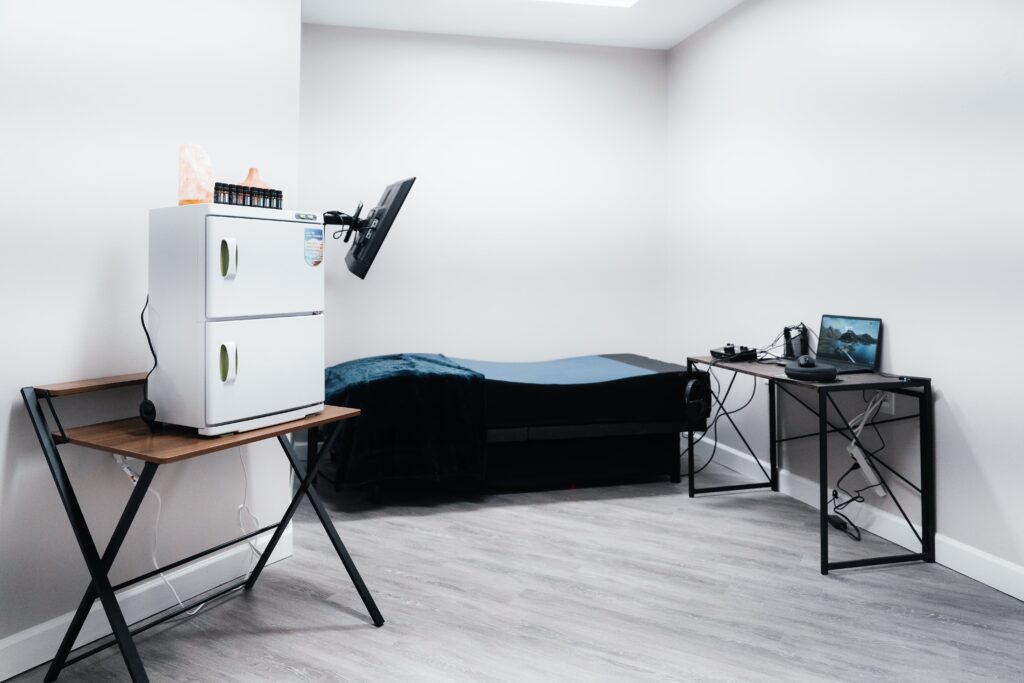One term that often causes confusion is “manic personality” – a phrase that’s commonly misused or misunderstood.
It’s important to clarify that there isn’t actually a “manic personality” as a standalone mental health condition.
Instead, mania refers to a specific type of mood episode that occurs in certain mental health disorders, most notably bipolar disorder. During manic episodes, individuals experience dramatic shifts in mood, energy, and behavior that are distinctly different from their baseline personality.
Mania represents an extreme elevation in mood that goes far beyond normal happiness or excitement. These episodes can significantly impact a person’s judgment, relationships, and daily functioning. Understanding the difference between temporary mood changes and clinical mania is crucial for recognizing when professional help is needed.
Symptoms of a Manic Episode
Manic episodes are characterized by a distinct period of abnormally elevated, expansive, or irritable mood lasting at least one week (or requiring hospitalization).
During this time, individuals typically experience three or more of the following symptoms:
Elevated Energy and Activity: People experiencing mania often feel like they have boundless energy. They may take on multiple projects simultaneously, work for days with little to no sleep, or engage in excessive physical activity. This heightened energy level is sustained and noticeable to others.
Decreased Need for Sleep: During manic episodes, individuals may sleep only 2-3 hours per night yet feel completely rested and energized. This dramatic reduction in sleep needs is often one of the first signs that a manic episode is beginning.
Grandiosity and Inflated Self-Esteem: Manic episodes frequently involve unrealistic beliefs about one’s abilities, importance, or special powers. Someone might believe they have exceptional talents, are destined for greatness, or have special connections to famous people or higher powers.
Racing Thoughts and Flight of Ideas: Thoughts may race so quickly that it becomes difficult to keep up with them. Individuals might jump from topic to topic in conversation, making connections that seem logical to them but confusing to others.
Increased Talkativeness: During mania, people often speak rapidly and excessively. They may feel pressure to keep talking and find it difficult to be interrupted or to pause in conversation.
Distractibility: Even with high energy levels, individuals experiencing mania often have difficulty focusing on tasks. They may be easily distracted by irrelevant stimuli or constantly shift their attention between different activities.
Poor Judgment and Risky Behavior: Manic episodes frequently involve engaging in activities with potentially serious consequences. This might include excessive spending, sexual indiscretions, reckless driving, or making major life decisions impulsively.
Irritability and Agitation: While mania is often associated with elevated mood, it can also manifest as extreme irritability, especially when others don’t share the person’s enthusiasm or try to set limits on their behavior.
Mania vs Hypomania
Understanding the distinction between mania and hypomania is essential for accurate diagnosis and treatment planning. Both involve similar symptoms, but they differ significantly in severity, duration, and impact on daily functioning.
Mania represents the more severe form of mood elevation. Manic episodes last at least one week or may require hospitalization due to their severity.
The symptoms of mania may be intense enough to cause significant impairment in work, relationships, or other important areas of functioning. During full manic episodes, individuals may experience psychotic symptoms such as delusions or hallucinations, and their judgment may be so impaired that they pose a danger to themselves or others.
More: What Is A Manic Episode Like?
Hypomania, which literally means “below mania,” involves the same types of symptoms but in a less severe form.
Hypomanic episodes last at least four consecutive days and are noticeable to others, but they don’t cause the same level of impairment as full mania. People experiencing hypomania can often continue working and maintaining relationships, though others may notice changes in their behavior, energy, or mood.
The key differences include duration (mania lasts longer), severity (mania is more intense), functional impairment (mania causes more significant problems), and the presence of psychotic symptoms (which occur in mania but not hypomania). Importantly, hypomania never requires hospitalization, while severe mania often does.
Both mania and hypomania are followed by periods of normal mood or depression, creating the cyclical pattern characteristic of bipolar disorder. Recognizing these different levels of mood elevation helps mental health professionals provide appropriate treatment and helps individuals and their families understand what to expect.
Types of Bipolar Disorder
Bipolar disorder is not a single condition but rather a spectrum of related mood disorders, each with distinct patterns of manic and depressive episodes. Understanding these different types is crucial for proper diagnosis and treatment.
Bipolar I Disorder is defined by the occurrence of at least one full manic episode. These manic episodes may be preceded or followed by hypomanic or major depressive episodes, but the presence of even one manic episode is sufficient for this diagnosis. People with Bipolar I often experience significant impairment during manic episodes and may require hospitalization. The depressive episodes in Bipolar I can be particularly severe and lengthy.
Bipolar II Disorder involves at least one major depressive episode and at least one hypomanic episode, but never a full manic episode. This condition is often misdiagnosed as major depression because the hypomanic episodes may be less noticeable or may even be perceived as periods of increased productivity and creativity. However, the pattern of alternating depression and hypomania is distinct and requires different treatment approaches than unipolar depression.
Cyclothymic Disorder represents a milder but more chronic form of bipolar disorder. For at least two years in adults (one year in children and adolescents), individuals experience numerous periods of hypomanic symptoms and periods of depressive symptoms that don’t meet the full criteria for major depressive episodes. While the symptoms are less severe than in Bipolar I or II, the chronic nature of cyclothymic disorder can still significantly impact quality of life.
Other Specified and Unspecified Bipolar Disorders include bipolar-like conditions that don’t fit neatly into the above categories. This might include situations where manic or hypomanic episodes are too brief to meet duration criteria, or where symptoms are caused by substances or medical conditions.
Each type of bipolar disorder requires a tailored treatment approach, as the frequency, severity, and pattern of episodes can vary significantly between individuals and across different types of the disorder.
Treatment for Manic Episodes and Bipolar Disorder
Effective treatment for manic episodes and bipolar disorder typically involves a comprehensive approach that combines medication, psychotherapy, and lifestyle modifications. At Arbor Wellness, we understand that successful treatment must be individualized to address each person’s unique needs and circumstances.
Medication Management & Psychiatry forms the cornerstone of bipolar disorder treatment. Mood stabilizers such as lithium, valproate, and lamotrigine help prevent both manic and depressive episodes. During acute manic episodes, antipsychotic medications may be necessary to quickly stabilize mood and address any psychotic symptoms. The medication regimen often needs to be adjusted over time as symptoms change and as individuals respond differently to various treatments.
Psychotherapy plays a crucial role in helping individuals understand their condition, recognize early warning signs of mood episodes, and develop effective coping strategies. Cognitive-behavioral therapy (CBT) helps identify and change thought patterns that contribute to mood episodes. Interpersonal and social rhythm therapy focuses on stabilizing daily routines and improving relationships. Family therapy can be invaluable in educating loved ones about the condition and improving family dynamics.
Lifestyle Modifications are essential components of comprehensive bipolar disorder treatment. Maintaining regular sleep schedules is particularly important, as sleep disruption can trigger mood episodes. Regular exercise, stress management techniques, and avoiding alcohol and recreational drugs all contribute to mood stability. Many individuals benefit from keeping mood charts to track patterns and identify triggers.
Crisis Intervention and Safety Planning are important aspects of treatment, especially for individuals who have experienced severe manic episodes. This includes developing plans for what to do if symptoms worsen, identifying support systems, and sometimes arranging for temporary hospitalization during acute episodes.
Ongoing Monitoring and Support ensure that treatment remains effective over time. Regular appointments with mental health professionals allow for medication adjustments, therapy sessions, and monitoring of symptoms. Support groups can provide valuable peer support and practical advice for managing the condition.
More: How To Deal With A Manic Person?
Begin Treatment for Bipolar Disorder Today
Understanding that a manic personality has much more depth than the term, individuals can break the stigma of mental health disorders. Recovery from bipolar disorder is possible with proper treatment and support. While the condition requires ongoing management, many people with bipolar disorder live fulfilling, productive lives. The key is finding the right combination of treatments and maintaining consistent care over time.
At Arbor Wellness, we’re committed to providing comprehensive, compassionate bipolar treatment. If you or someone you love is experiencing symptoms of mania or bipolar disorder, professional help is available, and recovery is possible. Call us now at 629-217-2658 or verify your insurance.

























